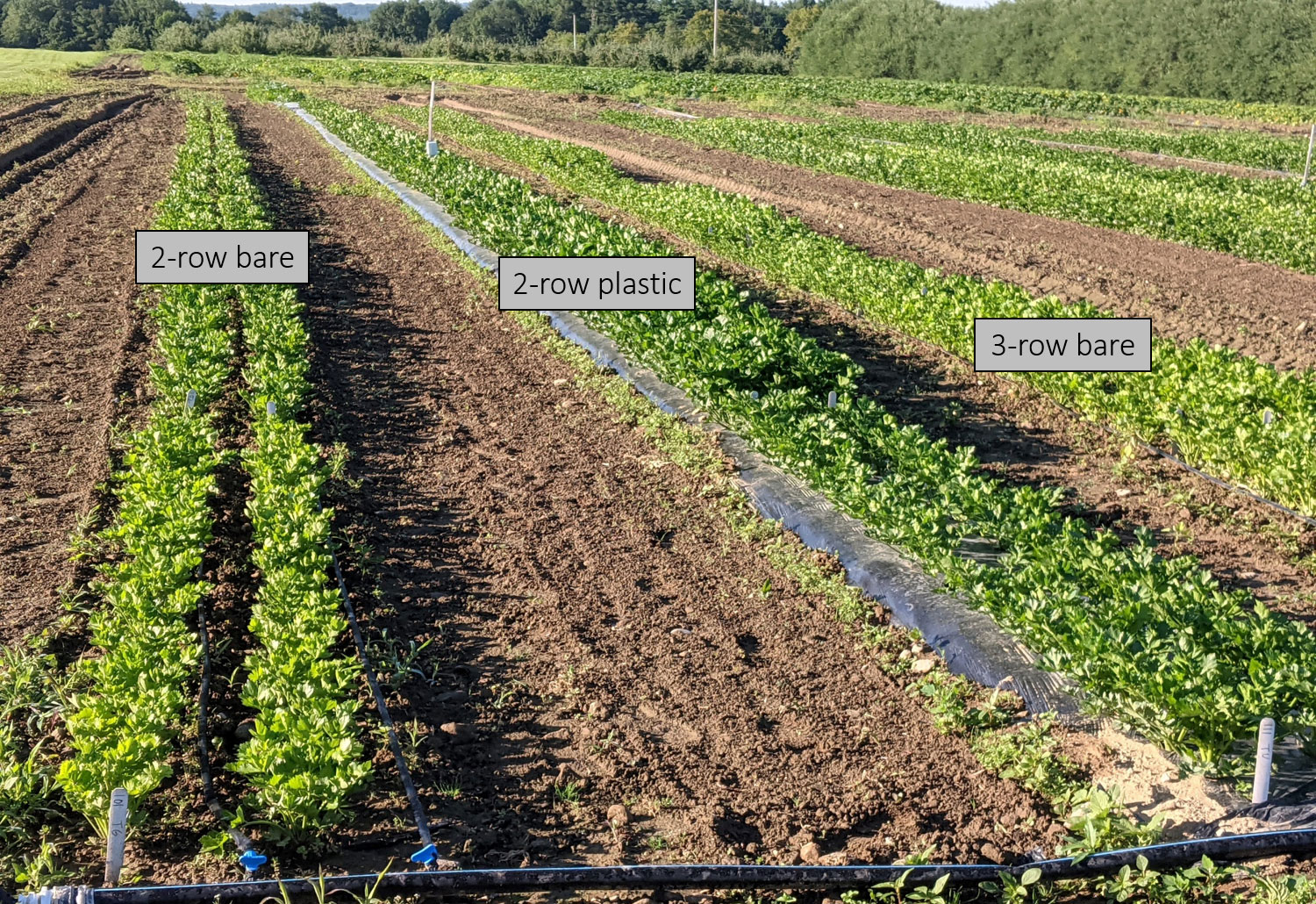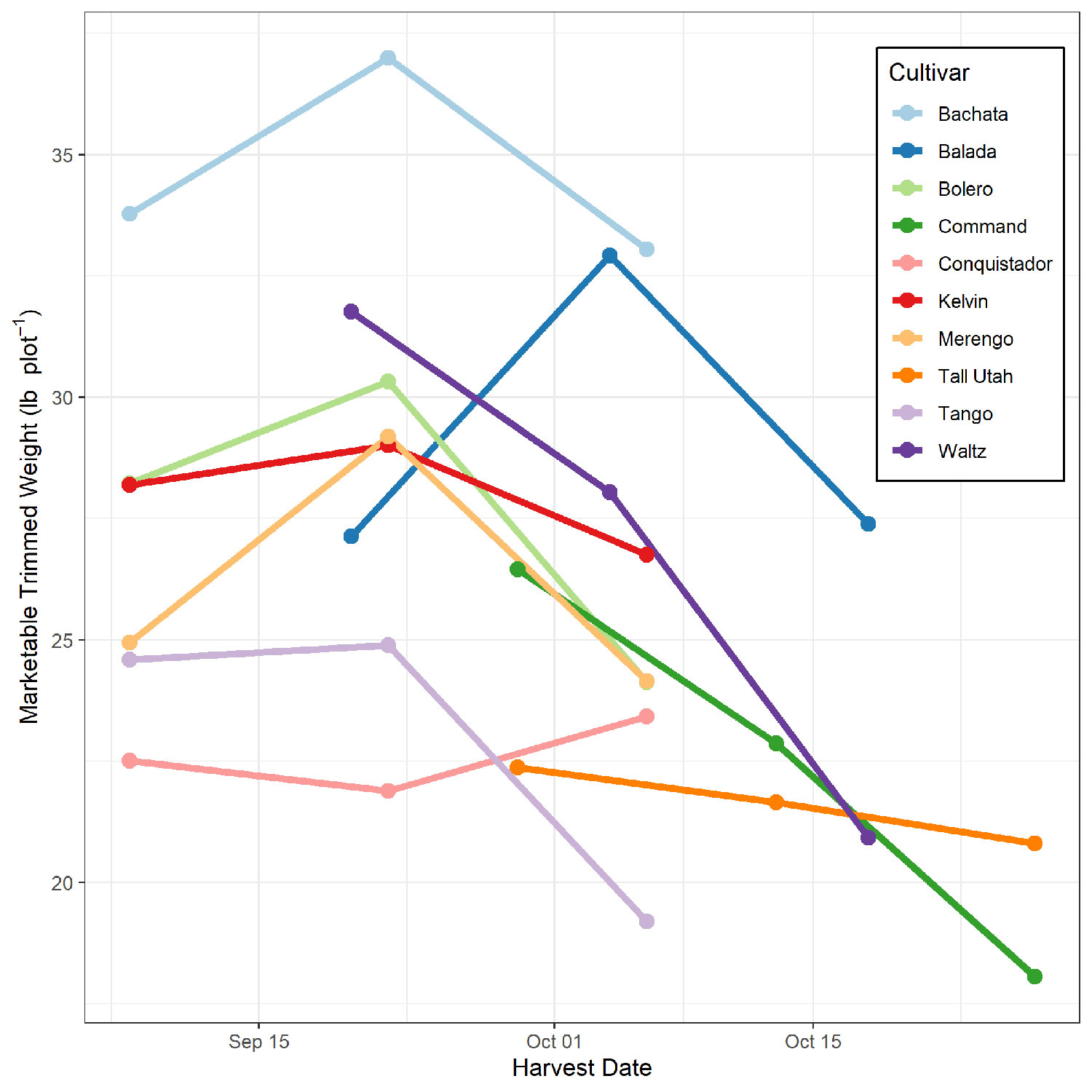Celery Evaluation: 2021 Research Report
Peyton Ginakes, University of Maine Cooperative Extension Research Associate
Mark Hutton, University of Maine Cooperative Extension Vegetable Specialist
Celery (Apium graveolens) is widely consumed across the US, but grown only in small quantities in Maine. Maine summers tend to be warm, humid, and have increasingly variable precipitation patterns. These growing conditions can result in celery that can be pithy and strongly flavored relative to what many consumers are accustomed to finding in grocery stores. A trial was begun in 2021 to develop celery cultivar and management recommendations for Maine farmers, and enhance the production of Maine-grown celery. Plastic mulched and bare ground planting systems using two planting densities were tested with multiple celery cultivars. These systems were selected under the hypothesis that black plastic would provide a more stressful (i.e., hot, humid) environment for celery plants, and therefore produce poorly relative to bare ground treatments. We also hypothesized that increased plant populations would further stress plants and reduce yield.
Seedling Production
Celery was seeded into flats filled with Coast of Maine compost-based media on Apr 12 at a density of about 6 seeds/inch and kept on heating mats at 70˚F. Seedlings were transplanted into 72-cell trays once they reached two true leaves (about 5-6 weeks). Seedlings were grown in a greenhouse until transplanted in the field. Ten cultivars were evaluated in 2021.
Field Trial

Seedlings were transplanted July 17, 9.5 weeks after seeding, into beds that had been prepared three days prior with 500 lb/ac of 10-10-10 fertilizer incorporated. Three planting systems were evaluated as main plot factors in a split-plot randomized complete block design, and cultivars were subplot factors. The three planting systems were: 1) 2 rows on black plastic mulch, 2) 2 rows on bare ground, and 3) 3 rows on bare ground.
All systems utilized 8” in-row spacing and 14” spacings between rows with one line of drip irrigation per row. The plots were 14 ft long with 40 plants/plot for two-row arrangements and 60 plants/plot for the three-row arrangement. The 2020 growing season was warm and dry from July through August, and very wet during September and October with temperatures about average for that time of year. The plots were irrigated to establish the transplants and then provided sufficient water to prevent obvious plant wilting.
Harvest
The first harvest of each cultivar was made when 80% of the plot had well-filled, marketable size bunches. A contiguous block of twelve plants was harvested from each plot at the first harvest date. Each plot was harvested three times with a second and third harvest following 14 and 28 days after the first harvest, wherein a contiguous block of six plants was harvested. Bunch weight at harvest was recorded. Bunches were then trimmed to marketable condition and weighed a second time.
Results
Growing Conditions
The 2021 growing season can be characterized as changeable. The spring and early summer were warm and dry, while the fall was warm and wet. July was unusually wet and cool, and August more typical for this region.
Data shown in tables and figures are in lb/plot. Specifically, a plot is equivalent to 8 row-feet.
Planting System Effect
Cultivar and planting systems both significantly impacted celery production. Plastic mulched plots produced the greatest yields. We observed that plants on plastic were larger and darker green than those on bare ground. It is possible that heavy mid-summer rains leached soil nitrogen from bare ground plots, while the plastic provided a degree of protection for soil nutrients (see Table 2).
Cultivar Effect
Bachata consistently produced the greatest yields at each harvest. In addition to Bachata, Waltz produced high yields at the first harvest. Tango and Tall Utah had the lowest yields at the first harvest. In the second harvest, Bachata yields were greater than Command, Conquistador, and Tall Utah. In the last harvest, Bachata continued to produce the greatest yields — more than Command, Tall Utah, Tango, and Waltz. Because the 2-row plastic mulch planting system produced greater yields than those on bare ground, and for simplicity, Table 4 shows the main effect of cultivar only within that single planting system.

Field Holding
Yield ranking by cultivar changed as the season progressed. In general, marketable yield declined later in the season. This was likely due to increasing weed pressure and, notably, pink rot (Sclerotinia sclerotium) that increased the number of field culls and necessitated more trimming to get heads to marketable quality. Therefore, cultivars that take longer to mature, which may have demonstrated greater field holding capacity in the absence of pest pressure, experienced declining yields from the first harvest. These include Tall Utah and Command, and to a lesser degree Balada and Waltz. Yield of cultivars that are quicker to mature tended to peak at the second harvest.
Acknowledgments
This work was supported by the University of Maine Agricultural and Forestry Experiment Station and the Maine Vegetable and Small Fruit Growers Association. Bejo Seeds, Stokes Seeds, and Coast of Maine generously donated materials for this project. This trial also benefitted from discussions with Jan van der Heide of Bejo Seeds. We are grateful for assistance from David Handley, Greg Koller, Patricia McManus, and Pete Lugner, as well as field assistants Ethan Handley, Lydia Handley, Lee Lavoie, Brooke Martin, and Taylor Truman.
For any questions or comments on this research, please contact Peyton Ginakes at peyton.ginakes@maine.edu or Mark Hutton at mark.hutton@maine.edu or (207) 933-2100.
© 2022
